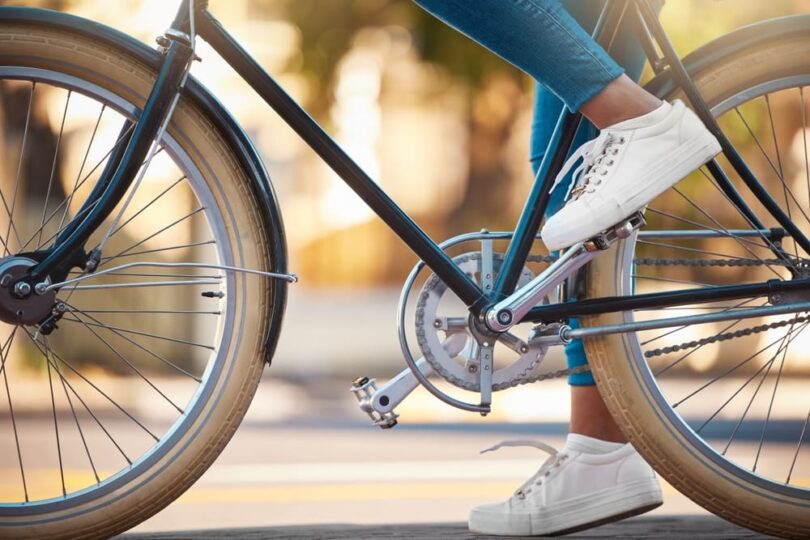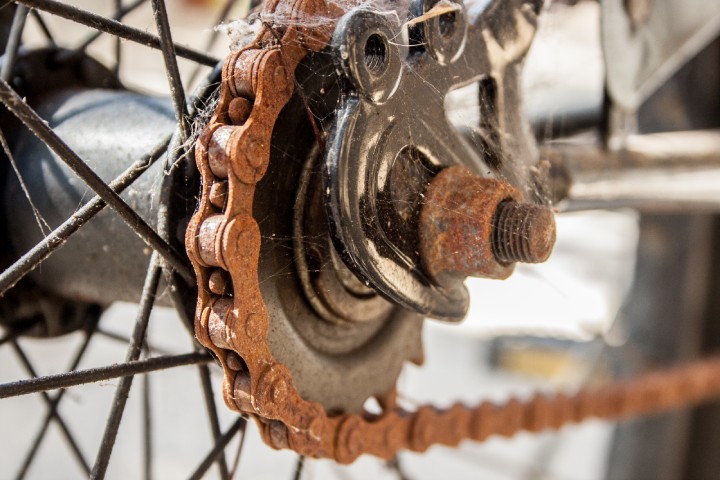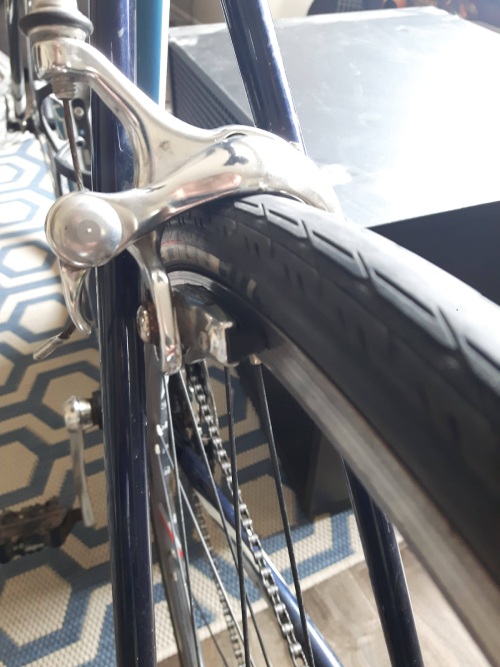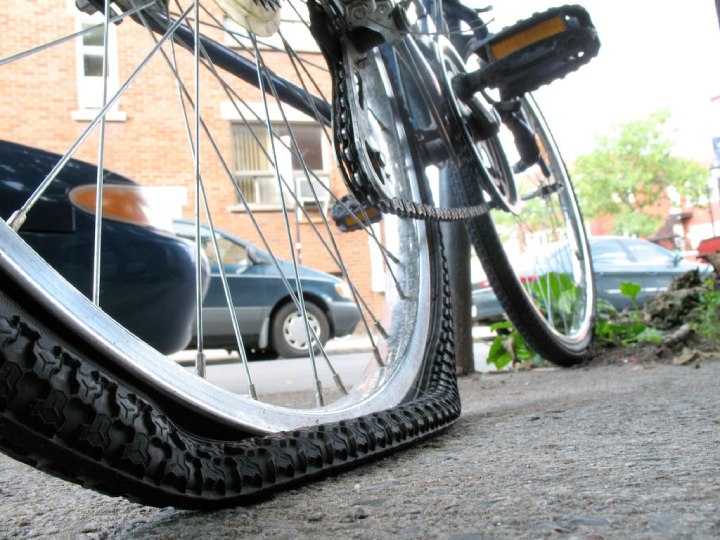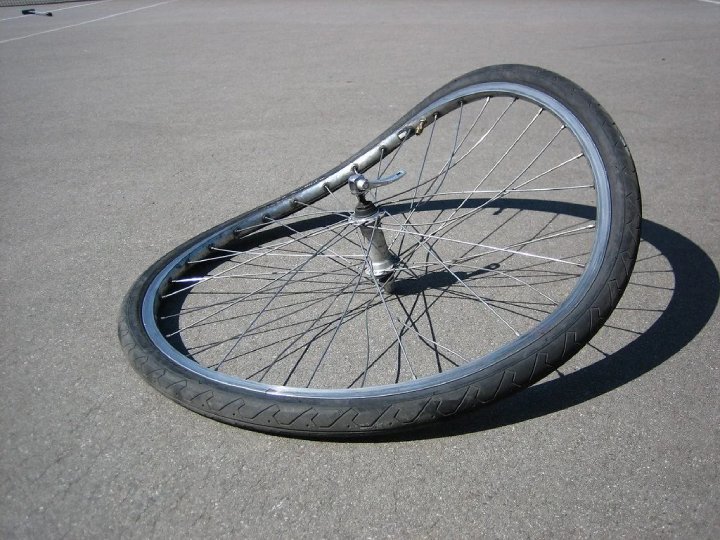“Why is my bike so hard to pedal?”
If you’ve ever found yourself struggling to pedal your bike, you’re not alone. There are many reasons behind this frustrating experience, ranging from chain and drivetrain Issues to mechanical issues to rider fatigue.
Here we’ll explore the common reasons and provide solutions to help you enjoy a smoother and more efficient ride.
Why Is My Bike So Hard to Pedal? : Possible Reasons & Solutions
1. Rusty Chains
When you first bought your bike, the chain was all smooth and shiny. But after riding the bike for some time, especially if in a wet area with dew and moisture on the ground, the chain must be rust now.
Over time, it’s possible for the rust to transfer to the other components of your bike such as the drivetrain. Eventually, the rust will jam your chain and make it harder for you to pedal because of increased friction.
Solution: Lube the Chain
Rusty chains are the most common cause of bikes becoming harder to pedal. The best way to fix this is clean up the dirt and debris from the chain using a degreaser. After that, lubricate the chain with a commercial oil. Here’s how you can do it-
Lubing the chain helps keep it protected from dust piling up. It also keeps the chain smooth and so with lesser friction.
However, if the chain is really old and rusted beyond the point of recovery, you have no other way but to replace it immediately.
2. Rubbing Tires
If the rubber of your tire is constantly rubbing against the mudguard or fender or any other component of the bike frame, the wheel can’t spin freely. As a result, you’ll find it hard to pedal your bike forward. The reason for the friction can either be that the tire is misplaced or that the size of the mudguard isn’t right for the bike.
Solution: Go DIY
Follow this simple tutorial:
3. Out-of-place Brakes
The rims of your wheels (both front and rear) can also rub against your brake pads. It usually happens when your brakes are totally out of place. Brake pads are supposed to stay in parallel with the rim and the gear of your bike. If this position changes somehow, you’ll feel a strong resistance while pedaling.
Solution: Check Your Brakes
If your brakes are not working properly, you should definitely check up on them. Misaligned brakes can cause your pedaling system to fail too. Make sure that the brakes are rightly placed. If you have mechanical disc brakes, you can simply tighten or loosen the cable and fix the problem. Video resources can help you the best here-
However, for hydraulic brakes, you need to handle the brake pad physically by taking off the wheels first. See this-
If you can’t manage on your own, consult an expert or your own manufacturer.
4. Low Tire Pressure
It’s obvious that a flatter tire or a tire with low air pressure is going to slow you down. The lower the pressure in your tires, the more the rolling resistance. Consequently, you can’t bike as easily.
Solution: Inflate the Tires
Don’t ever forget to check the tire pressure. But first, remember that not all tires are compatible for all tracks. You can’t expect to race professionally with mountain tires nor can you climb the hills with slick road tires. Choose your tires accordingly when installing your bike components. Get in touch with the manufacturer if necessary.
Now, if the tire has lower air pressure, it has the risk of going flat. You can’t drag on a flat tire for your rides. It’ll produce more friction and reduce your speed. Make sure to inflate the tires with a bike pump.
This video like the one below can give you an idea of how to do it:
However, too high tire pressure can also be dangerous. Always maintain a balance and know your optimal tire pressure to ride safe.
5. Out of True Wheels
If your wheels aren’t true, they can make your bike sluggish. Uneven wheels move laterally and spoil your balance. Also, misaligned wheels can touch your brake pads while spinning and eventually make it difficult for you to control the composure of your bike.
We always talk about what happens when your wheels are unevenly installed. However, it’s also possible to overtighten your wheels especially in bikes with cup and cone bearing axle systems. If the wheels are too tightly adjusted, they can’t spin well and that makes it hard to pedal.
Solution: Align the Wheels
Find out if there’s a misalignment within your wheels. If there is, you have to fit them accordingly.
If there is any problem with the wheels, they’ll likely produce a sound when you ride the bike. But some slick tires don’t make noises even when the tire is facing obstruction. We recommend that you check the wheels visually from time to time. Spin the wheels to see if they are rubbing against any part of the bike frame such as the fender or of the brake system.
Usually, it happens when the spoke of your wheel is misplaced. You may have to readjust it. However, if the spoke or the hub or the rim is broken, you have to replace them. Same goes for the bearings. If you’re new to riding bikes, you should leave it up to the manufacturers.
You should also look for any foreign objects or debris attached to the tire because junks like them can also cause the wheels to rotate abnormally.
6. Gear Issues
If you’ve just bought a bike, you can get confused between different gears and so select the wrong one for your ride. You can’t expect to have a good cycling experience without using the right gear.
For example, we all know that it’s easy to pedal in low gear. But you need to ensure more pedal revolution to bike faster. This is typically the case when you’re going uphill or carrying some goods.
On the contrary, high gear bikes are harder to pedal. You have to spend more energy to achieve the same speed as any low gear driven bike. Bikers usually use high gears when they want to go downhill on a slope or speed away on the road for workouts.
On flat surfaces, you can’t fix on a specific gear. You have to alternate between the gears and find a balance for a decent speed.
Sometimes, if you haven’t been cycling for a while, it’s possible that your bike will be stuck on a single gear. It becomes extremely hard to pedal then.
If your gears don’t align with gear shifters, they keep changing randomly, which creates a challenge for you to climb uphill with the bike.
Solution: Adjust Your Gears
Sometimes, it’s only about choosing the right gear! Try out different gears to find the one you’re comfortable with when pedaling your bike. You may have to shift gears based on the terrain. Take your bike in different terrains and learn to use the correct gear.
If your bike is stuck on one gear or the gear cables are damaged, you’ll need to replace them. So, check them out as well.
7. Over-tightened or Loose Pedals & Wheels
Have you ever done maintenance on your bike and then asked yourself “why is my bike harder to pedal?” Well, it happened because you have either over-tightened your pedal components or kept them too loose. Both these cases will affect your pedaling speed while driving.
If your axle, hub, bolts, pedal crank arm, pedal, and derailleur are too tightened, they’ll grind heavily and damage your pedal system.
On the other hand, if they’re left loose, the pedal will spin at a higher speed than usual. This will also make you uncomfortable.
The bottom bracket attaches the pedals to the bike frame. If the bottom bracket is in any tension, it will be physically too difficult to rotate the pedals anymore.
Solution: Fix the Pedal Issues
All the components attached to the pedal such as the axle, pedal crank, and bottom bracket can be culprits. Usually, they are too tightened or too loosely adjusted. Whatever the case may be, you need to check on them and figure out the problem.
You can loosen them up or apply grease and then see whether they spin smoothly or not. If not, they’ve probably worn out and if any one of them is damaged beyond repair, you have to replace them.
You can use SPD pedals to improve your pedaling speed. SPD pedals give you enough space to push with your feet so you can transfer more energy into them easily. You can also pull the pedals up using more energy, which makes the pedaling a lot easier.
Broken Bearing Systems
Speaking of bearing systems, there are mainly two types – Cartridge System and Cup-and-Cone Bearing System. No matter which one you use, the problem originates from the bearing itself. As bearings age and wear out, they get deformed and lose their spinning capability. As a result, it becomes multiple times more difficult to roll the wheels.
8. Undersized Bike Frames & Wrong Saddle Height
Structure of your bike itself also impacts the pedaling ability. The size of the bike frame is one example. If your bike frame is too small for your height, you’ll have less room to pedal and so you can’t generate enough power into your pedaling.
This one is the total opposite of what we were talking about just now but makes you uncomfortable all the same. When your bike seat is too high, you can’t reach the pedals properly and so you’ll probably start rocking back and forth on the seat.
This is not recommended since you’ll not only fail to pedal with ease but you may end up in an accident.
Solutions: Adjust the Seats
If your saddle height is too high or too low, it can hamper your cycling experience. Adjust the seat, handlebars and cleats as per your comfort. Set the pedal to the lowest position and reach with your feet sitting straight up. This position will ensure that you’re comfortable with your saddle height and can ride without any problem.
9. Maybe, It’s You
Don’t be mad now! Genetics has a lot to do with the activities we perform. Maybe, you’re not fit enough to ride your bike yet and that’s completely okay!
Also, if you don’t have any experience in cycling and are just starting out, it’s only normal that you’ll struggle to pedal like the regular bikers.
Some have got problems with climbing up or down the mountain due to inexperience. For example, if you don’t know that you need to use lower gear to go uphill, you’ll find pedaling to be tremendously difficult with a higher gear.
Similarly, if your pedaling techniques are not good enough, you can’t expect a smooth ride with your bike just yet.
Solution: Keep Riding
Well, as we’ve said before, inexperience can also be a factor for your failure to pedal easily. But don’t you lose hope! You should just keep cycling as much as possible to improve your pedaling skills. Try biking on difficult terrains such as the uphill slopes once in a while to add to the experience. Take your cycling as a form of workout and watch yourself become an expert in your own routes.
10. Other Reasons
Several other factors can give you a bad day with pedaling such as-
- If your chain falls off the drivetrain components such as the cassette or the chainrings, you can’t move forward no matter how much you pedal. That’s because your drivetrain is no longer operational since it’s lost its contact with the chain.
- If your derailleur (a component that moves chains from one gear to another with each gear shift) is stuck, it will lock your chain and stop you right in the track.
- If you haven’t tuned up your bike for a long time, the cables can wear out and become loose. This also causes inconsistent gear shifting.
- Usually, traction in your tires is important but not always. In rough roads, traction helps you surge forward easily while in smooth roads, it’ll only hold you back.
Solution: Fix the Drivetrain Issues
The drivetrain of your bike contains the chain, the chainrings and the derailleur. All of them are vital components allowing you to pedal efficiently.
Mostly, you’ll have to see whether they are loose or over-tightened. A loose chain can’t generate enough power and transfer to the pedals. A tightened chain will require an unnatural amount of energy and make it difficult for anyone to pedal as usual. You have to adjust the chains accordingly. This video serves as a DIY solution for you-
A smaller chainring can cause the chain to fall off while a too large one can make your bike slow down. So, choose the chainring carefully.
A misaligned derailleur can also be troublesome by interrupting your gear shifting. Inspect if the derailleur hanger stands straight. If not, try to fix it by using two limit screws attached with it. If you’re not familiar with all these, you can follow the process in this wonderful video beginner-friendly video-
But it’s better if you leave the handiwork to the manufacturers in a bike shop.
Tips to Keep Your Bike Chain Smooth
So, a new question now pops up- “What makes a bike easier to ride?” We’ve got you there as well. Just follow these simple tips to prevent or fix your bike pedaling problems.
-
Inspect the Bike
Always check if anything’s wrong with the bike before you ride out with it. Make it a routine. Check all the essential components starting from the bike seat to the drivetrains, brakes and gears. If you find anything fishy, don’t ignore it. Either send the bike to services or if it’s something simple, look for some DIY solutions.
-
Conduct Routine Maintenance
If your bike’s not showing any sign of damage, you should still consider checking up on all the compartments. Keep your wheels and drivetrain clean. Try to find out the misaligned parts on the bike and adjust them properly. Still, things will escape your attention. In that case, you can invest in a bike expert or trainer or simply take it to a local shop.
Final Thoughts
If you’re struggling with the question in mind “why is my bike so hard to pedal?”, we believe this article will surely help you pinpoint the problems and then solve them. Remember, it’s up to you to take care of your own bike. Never leave any of your bicycle parts unchecked or they can make your life hard. Consult with your local manufacturer if necessary and enjoy a nice ride!
FAQs
Q. How do I make my bike pedal easily?
Ans. If your bike is alright otherwise, choose a lower gear to pedal easier. Surely, you’ll have to rotate the pedal more than usual but you’ll feel how easy it’s become to do so.
Q. How do I fix a stuck pedal on a bike?
Ans. Clean all the dirt on your pedal and use grease while attaching the pedals to the crank. Often you’ll see the bearing balls coming off loose. In that case, you might have to buy a new pedal.
Q. Are heavier bikes harder to pedal?
Ans. Yes, heavier bikes are generally harder to pedal. The additional weight makes it more challenging to accelerate, climb hills, and maintain higher speeds compared to lighter bikes.
4. Why does my bike feel so heavy?
Ans. Your bike might feel heavy due to factors like a heavy frame, low tire pressure, cargo, or worn-out components, all of which can make pedaling harder and the bike feel heavier.
5. How often should I replace a bike chain?
Ans. It depends on the bike itself and other criteria such as the riding condition, time spent and maintenance. But typically, you should expect about a cumulative 2000-3000 miles of coverage before changing the chain.

